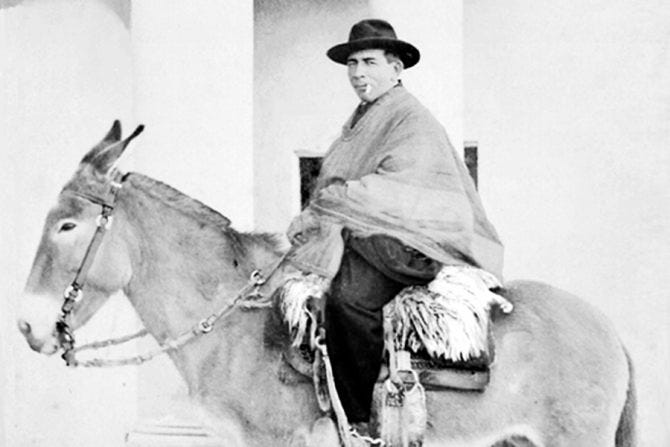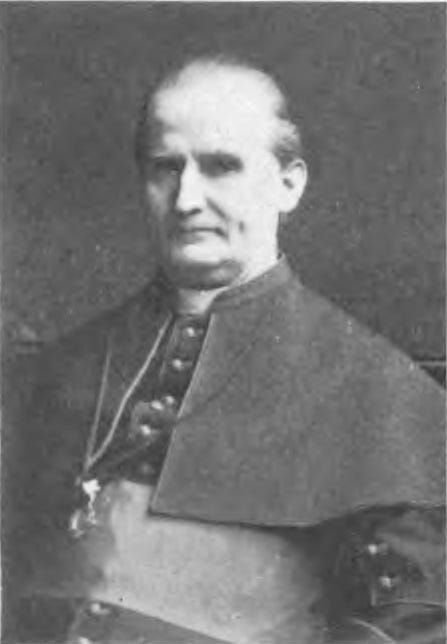
The Patron Saint Thanksgiving Showdowns™ - Are you ready for some football?
Turkey Day Gridiron Analysis
Thanksgiving is a day for family, for food, and above all for blessing God, and His abundant providence.
Of course, for many American families, Thanksgiving is also a day for football.
Across the country this Thursday, families will eat pie and take sides over the big games, as their teams face off on the gridiron.
Conventional wisdom would make game-day predictions based on team records, player form, and, failing all else, hometown pride. But here at The Pillar, we know better.
So for your Turkey Bowl enjoyment, we give you The Pillar’s Patron Saint Thanksgiving Showdowns™ — which will actually decide the day, even if the players, coaches, and most of the fans don’t know it.
Let’s face it, readers: hagiography might be an imperfect way of calling football games, but it’s a lot more interesting than reading about the NFL.
St. Corbinian’s Chicago Bears vs. St. Leo the Great’s Detroit Lions
Why St. Corbinian for Da Bears: He made a bear carry him across the Alps.
Why St. Leo the Great for Detroit: Leo means lion.
The matchup
This is the big-time contest, pitting two old-word heavyweights against each other in the marquee game. Let’s take a look at the players:
Born around 680 AD, little is known about the early life and childhood of St. Corbinan, but he came up through the ranks the old-school way: building his reputation as a spiritual director and miracle worker while living for nearly a decade and a half as a hermit near the church of Saint-Germain in Chartres, France.
After a community grew up around his hermitage, Corbinian dedicated more and more of his time to instructing them in a life of prayer. He was eventually made a bishop, but he began to miss the solitude and time for personal prayer.
Corbinian made a pilgrimage to Rome in, we think, about 723, to ask the pope to let him resign as a bishop and return to his eremitical life. On the way, though, Corbinian’s horse was attacked and killed by a bear.
The saint wasn’t about to walk through the Alps, and was more than a little annoyed at the loss of his ride. Legend has it that he rebuked the bear, and ordered it to carry him the rest of the way to Rome — or maybe from Rome, depending on which account you read. Either way, a bear wearing a saddle became his symbol.
Of course, when Corbinian got to Rome, apparently riding a bear, Pope St. Gregory II wasn’t hearing a word about his resignation, and sent him instead to the Barvarian city of Freising as a missionary bishop. To the best of our knowledge, he got another horse for that trip.
Pope St. Leo I was a Hall of Fame papal player, and always in the mix for conversations about the G.O.A.T — after St. Peter, of course.
Reigning as pope from 440-461, Leo was a ferocious tackler of all the big-time heresies: Monophysitism, Nestorianism, Manechaesim, Pelagianism — most of the big “isms,” really.
He set the table for the Council of Chalcedon, and defined the dual nature of Christ as both true God and true man in one person, “with neither confusion nor division.”
As pope, he also had to contend with the collapse of the Western Roman Empire. Leo helped cement the See of Rome as a focal point for secular as well as spiritual authority, and helped define the doctrine of Petrine primacy. When he wasn’t wrangling powerful bishops back into line, he was meeting with Attila the Hun, aiming to persuade him not to sack the Eternal City.
The Pillar predicts
While only the Church’s hierarchy can declare a person to be a saint, the title “great” is conferred by popular acclaim. The people of Rome, and the vote of history, are on the Lions’ side in this one, so expect them to send the Bears back to the woods.
Detroit will roar to victory.
St. Patrick’s Las Vegas Raiders vs. St. Jose Gabriel del Rosario Brochero’s Dallas Cowboys
Why St. Patrick for Las Vegas: He was kidnapped by raiders.
Why St. Jose Gabriel del Rosario Brochero for Dallas: He’s the cowboy priest.
The matchup
Based on this season’s form, these two seem evenly matched heading into their Thanksgiving meetings. But dig a little deeper and there’s two very different saints to consider in this game. Let’s look at the form:
St. Patrick, Ireland’s most famous immigrant, owes his road to sainthood to a gang of Irish raiders who kidnapped him from his home in Wales and sold him into slavery at the age of 16.
The fifth century saint got his first taste of pastoral life literally tending flocks of sheep belonging to a local Irish chieftain, and it was on the hills that Patrick had his first profound experiences of prayer. He would eventually escape after years in captivity, making his way back home after a 200 mile walk to an Irish port and begging passage on a ship leaving for Britain.
Once home, his desire to live more deeply the Christian life never left him. In his Confessio, Patrick reports having a vision of “a man coming, as it were, from Ireland,” and handing him the pleas of the Irish people to hear the Gospel.
After training for the priesthood in France and being ordained by St. Germanus of Auxerre, Patrick went back to Ireland where, by his own account, he baptized thousands.
It wasn’t always smooth sailing for him, though. As a bishop, he had a habit of refusing generous gifts from local leaders. That kept him free from ties of influence, but it also made him seem suspicious to local chieftains, and to other missionaries less concerned about the practice.
St. Jose Gabriel del Rosario Brochero was born in Argentina in 1840. One of eight sons, he also had two sisters, both of whom became nuns, Jose ended up proving to be one tough hombre when it came to the faith.
He entered the seminary at 16 and was ordained a priest at 28 for the Archdiocese of Cordoba. He found himself first teaching in a seminary before being assigned to minister in the very, very, rural parish of St. Albert. This was not your typical suburban assignment; Fr. Jose had to tend to a flock of more than 10,000 souls, spread over about 1,500 miles of uplands.
He was known for riding a donkey around his super-sized parish, wearing a poncho, smoking cheroots, and earning a great nickname: The Gaucho Priest.
Fr. Jose Gabriel del Rosario Brochero was also famous for a no-holds barred approach to tackling ministry, keeping close to the poor and sick with intense personal devotion and attention, even during a cholera epidemic.
“Woe if the devil is going to deprive me of a soul,” he reportedly said. Such was his shepherd’s devotion to the flock that he eventually contracted leprosy by caring for the sick.
He died in 1914, at home with his sisters, after his condition eventually took his sight and his hearing. Before he was canonized in 2016, Pope Francis praised him as a priest who truly smelled like his sheep.
The Pillar predicts
Patrick gets all the hype, and he’s more than earned it. But never sleep on the guy with a cigarette and a sombrero.
The Cowboys will prevail.
Venerable Fr. Nelson Baker’s Buffalo Bills vs. St. Joan of Arc’s New Orleans Saints
Why Venerable Nelson for Buffalo: He’s a hometown boy made good.
Why St. Joan for New Orleans: The Maid of Orleans always liked a good fight.
The matchup
On paper, this is a mismatch. The battle-hardened and martyred Joan would surely come out on top over a Venerable priest, still working his way towards the big time.
But never underestimate a home-team underdog story.
The Venerable Fr. Nelson Baker was born in the Nickel City in 1842. Though his father was a Lutheran, his devout Irish mother made sure he and his siblings were raised in the Church — though young Nelson was only baptized at age 9.
A soldier in the Union Army during the Civil War, Baker’s regiment saw action at home, quelling the draft riots in New York, and at the Battle of Gettysburg. After the war, he went into the grain business, but became interested in the work of the Society of St. Vincent de Paul back in his hometown.
He entered seminary in 1869, making his mother very happy, but his father and business partner less pleased. He became a parish priest in Limestone Hill, part of Lackawanna, New York, outside Buffalo.
But as a pastor, Baker was confronted with parish finances seriously in the red. He donated his personal savings to keep creditors at bay, promising that, as a man of business, he’d make good on the balance. What he did next earned him a reputation as a gifted fundraiser and innovative manager.
After talking local postmasters into giving him the addresses of area Catholic ladies (privacy laws weren’t such a big deal back then), Baker wrote to all of them, asking for a pledge of 25¢ per year to join his newly minted Association of Our Lady of Victory. After paying off the debts, the association funded local orphanages and other Catholic institutions.
As the city of Buffalo grew, with immigrants flocking to fuel its industrialization, Fr. Baker was made vicar general of the diocese in 1904. His administration of the diocese and care for the working communities earned him the nickname “The Padre of the Poor.”
In 1923, he was granted the title Monsignor by the Vatican - one of only five American priests to have it at the time. In 2011, Pope Benedict XVI recognized his heroic virtue and declared him Venerable.
St Joan of Arc and her story is legend and history all rolled into one. Born into a peasant family, the child Joan was known for her happy and devout piety. But she was more than just a country girl: she heard voices of the saints, including St. Michael the Archangel, whispering a great mission to her.
That mission was to lead the French army in its battle against the English, with Heaven’s choice lighting upon the 13 year-old girl, presumably because no halfway competent Frenchman could be found to do the job.
After a stunning series of victories, most famously breaking the siege of Orleans —earning her the nickname the Maid of Orleans — she was captured by Burgundian forces and put on trial for heresy. Despite offering flawless answers to her interrogators, she was condemned and burned at the stake, only to have her name and sanctity vindicated by a papal investigation shortly after her death.
Despite legendary status in her native land, and a clean theological bill of health from the Vatican, Joan’s cause for sainthood took a long time to come through: Even in the early twentieth century, Roman officials were iffy about opening the celestial books up for someone who, in the end, was a soldier. But canonized she was, in 1909. Pope Benedict XV’s bull announcing the decision made it clear God was on her side all along.
The Pillar predicts
You have to expect Joan’s saints to march all over the Bills, but we love a good underdog. And Venerable Fr. Nelson is looking to work some miracles on his way to sainthood.









This is probably the first time in history that "Great" and "Detroit Lions" occupied the same sentence.
This is sheer brilliance. Also, will hopefully make a bunch of football homilies at least a little better connected to faith.